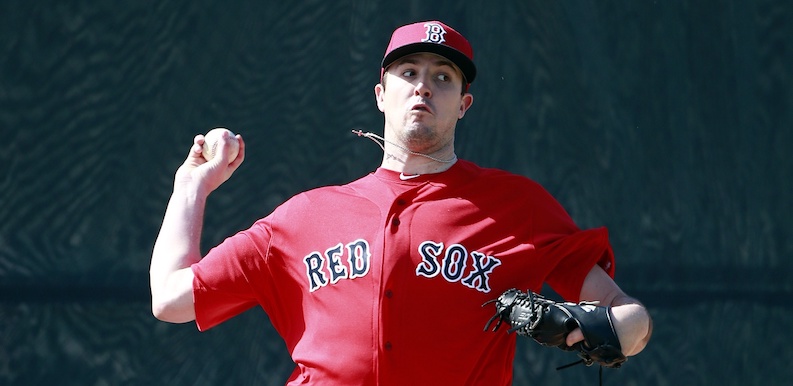As he begins throwing off mounds and traveling throughout suburban New England on rehab assignments, it’s time to get excited about Carson Smith again. Waiting for Smith has been like when your best birthday present requires batteries that you don’t have, so you sit there staring at it angrily for half a day before you whine enough to get one of your parents to cave and buy some. Getting Smith back is obviously good news – when healthy, he was one of the game’s elite relief pitchers.
Point is, this isn’t necessarily a bullpen that needs saving. Luckily for the Sox, a bullpen-saving talent is theoretically what they’re getting from Smith.
It gets even better when you realize that this Red Sox bullpen doesn’t necessarily need him. That’s not to say he’s expendable, or that the current bullpen is overflowing with more appropriate 8th-inning options. It simply means that the Sox bullpen, as you surely know by now, has been doing fine without him. As of Wednesday night, they’re 6th in K-BB%, 4th in FIP, 4th in LOB%, and 3rd in WHIP. They’re rank in the top-10 of a lot of other stats, but long lists are tedious and redundant. Point is, this isn’t necessarily a bullpen that needs saving. Luckily for the Sox, a bullpen-saving talent is theoretically what they’re getting from Smith. So assuming he shakes off the rust and settles into a killer set up guy, here are a couple things that the Sox should get from the twenty-seven year old righty.
The first thing that you remember when you think of Carson Smith is that he gets all the Ks. This is not news for anyone who’s followed Smith’s career, but seriously, the dude can strike a batter or two out. Over 81.1 career innings, Smith’s averaged over 11.5 strikeouts per nine innings. In his one full season of work (2015) his K% (32.4) was good for 11th best in all of baseball. That news becomes even better when you realize that through 170 innings of work this season, the Red Sox already hold the 9th best K% in baseball (26.1).
This year, the league average for K% is 23.4 percent. Of the four most heavily relied on Red Sox relievers (Hembree, Kimbrel, Barnes and Kelly), only Kimbrel and Barnes have a higher-than-league-average K%. Basically, the Red Sox bullpen’s status as a top-10 team in K% is heavily buoyed by Kimbrel’s absurd strikeout rate (55 percent – almost nine percentage points higher than the next closest pitcher). Take him out of the picture, and the Sox are very much average at getting whiffs. The return of Smith gives the Red Sox another legitimate option when they need someone to miss bats.
The bigger impact Smith brings to the bullpen is a more established pecking order. As he eases his way back into major league action, it’ll be interesting to see how long (if at all) it takes Farrell to insert Smith as the go-to guy in the 8th. So far, here’s a look at what the 8th inning has looked like for the bullpen:
Joe Kelly: 8.2 IP, 22.9 K%, 11.4 BB%, 2.60 FIP, 1.15 WHIP
Matt Barnes: 13 IP, 25.9 K%, 13.0 BB%, 1.23 WHIP
They’re not the most reliable sample sizes to work with, but you can get a sense of what the Sox are getting from their primary set up guys. What sticks out, for both, are the walks. In 2017, the league average for BB% from AL pitchers in the 8th inning is right at nine percent, and the K% is 25 percent on the nose. It’s not the cleanest comparison, but it does show that the Red Sox have had below-average production from the setup role so far.
This is where Smith comes in. During his healthy season in 2015, the Mariners used Smith in the 8th more than any other inning. The results? A 32.7 K%, 7.1 BB%, 2.37 FIP, and a 0.98 WHIP. That’s what an elite set up man looks like. Hell, that’s what an elite closer looks like.
In a time when the best bullpens feature an established pecking order from the 6th inning on, Smith’s return provides some much-needed stability. It’s tempting to shove Joe Kelly into the back-end of the bullpen because he throws 102 miles an hour, but the reality has always been that high-leverage situations never quite agreed with him. Between the low, medium, and high leverage situations that Kelly has faced over his career, he’s struggled the most during those high-leverage innings. While he’s shown promise making the transition from starter to reliever, his stats regress significantly below both career and league averages when he’s pitching in high-stress situations. The same goes for Barnes, although his strikeout rate doesn’t plummet quite like Kelly’s does.
Realistically, neither Kelly or Barnes are ideal setup options. Kelly fits much better as a matchup-based option, as his numbers this year against right-handers are actually pretty good. In fact, Kelly’s numbers against right-handed hitters are significantly better than Hembree’s – the only relief pitcher on the team that’s seen more innings against righties. Matchup specialist might be an underwhelming ceiling given all his Great Stuff potential, but there’s unquestionable value to being successful in the role that Kelly seems to be most comfortable in. That’s why Smith’s addition is so important to the team: not only does it give the Red Sox an elite setup man, but it gives them the depth and flexibility to reshuffle the deck, putting guys in positions they’re much more likely to succeed in.
